The UK remains the world’s largest net exporter of financial services – but the underlying data show how the picture has been changing over time.
Our recently-launched ‘Key Facts about the UK as an international financial centre’ report found that the UK continues to record the world’s largest trade surplus in financial services. As our research makes clear, US financial services exports exceed those of the UK, but when the net position (exports minus imports) is considered, the UK leads because its financial services imports are considerably less than those of the US.
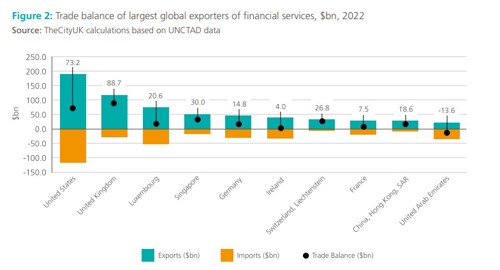
The gap between the UK’s and the US’s financial services trade surplus has narrowed over time
Additional analysis of the data over time shows that the UK’s lead over the US in terms of this trade surplus has narrowed considerably over the past decade and a half. The UK surplus has been fairly steady over this period, at around $87bn a year. At the same time, the US’s surplus has increased dramatically, from $5.4bn in 2008 to $73.2bn in 2022.
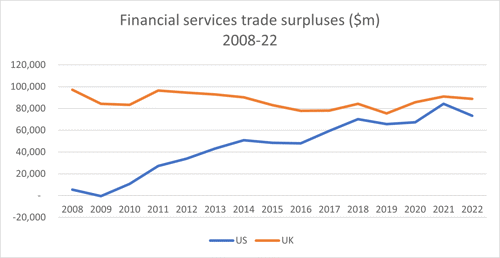
Source: UNCTAD
This dynamic has been driven by very strong growth of US financial services exports. US financial services imports have remained relatively steady, albeit with a noticeable uptick since 2018. US financial services exports, on the other hand, more than doubled, rising from $93bn in 2008 to $190bn in 2022:
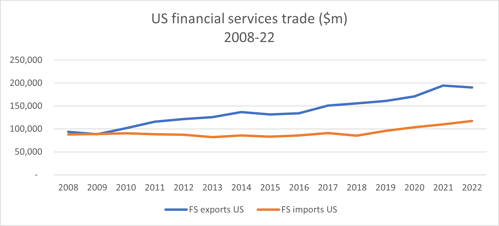
Source: UNCTAD
This much faster growth of exports than of imports means that the trade surplus increased significantly. In contrast, both exports and imports of UK financial services were relatively flat, explaining why the trade surplus has been maintained but not grown:
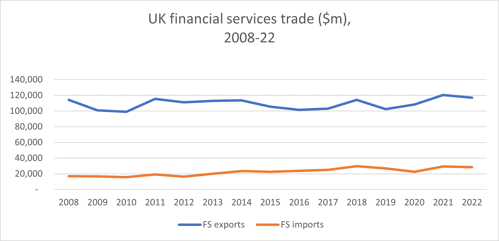
Trade asymmetries mean that a definitive picture of bilateral services trade is elusive
It’s worth noting that analysis of US-UK services trade is greatly complicated by the presence of what are known as ‘asymmetries’ in bilateral trade data. In this context, ‘asymmetries’ refers to discrepancies in bilateral trade figures between the two countries involved. For example, if Country A shows a trade surplus of $100 with Country B, then Country B’s official statistics should show a trade deficit of $100 with Country A. I have written previously about trade asymmetries here. Of course, sometimes Country A and Country B might record slightly different figures for a surplus/corresponding deficit—but sometimes the discrepancies paint totally different pictures of trade relationships. US-UK financial services trade offers one such example.
In its latest update on this issue, the Office for National Statistics (ONS) notes that ‘the most substantial asymmetries tend to be observed in the service types "Financial services", "Other business services" and ‘’Telecommunications, computer & information services’’. This provides some context for the fact that although ONS data indicate a UK financial services surplus with the US of £25.6bn, US Bureau of Economic Analysis data show a UK financial services deficit with the US equivalent to £3.1bn. The ONS offers several possible explanations for trade asymmetries, including differences in survey methodology and coverage, the difficulty of measuring digitally delivered trade, and differences in how various items are described and classified[1].
The trade asymmetry issue is particularly relevant for UK-US trade; according to the ONS’s latest available estimates, the UK’s trade asymmetries with the US dwarfed those with other trading partners:
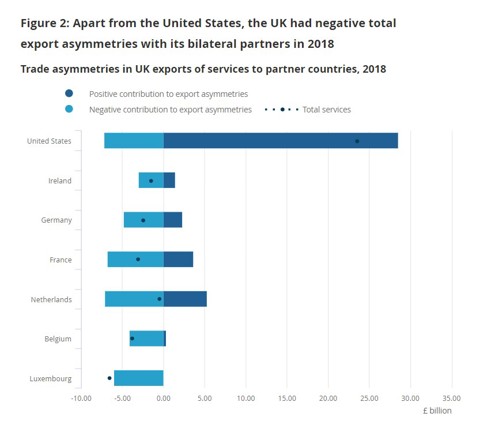
Nevertheless, since the UK and the US are—by a large margin—the world’s two largest exporters of financial services, and also each other’s largest financial services trade partners, it makes sense to analyse this particular trade relationship in a bit more detail. I will explore this in my next post, focusing on ONS data.
Read my next blog: What does UK-US financial services trade comprise?
[1] ONS, Trade in Services Asymmetries – the challenges of measuring imports and exports, 23 December 2022.

